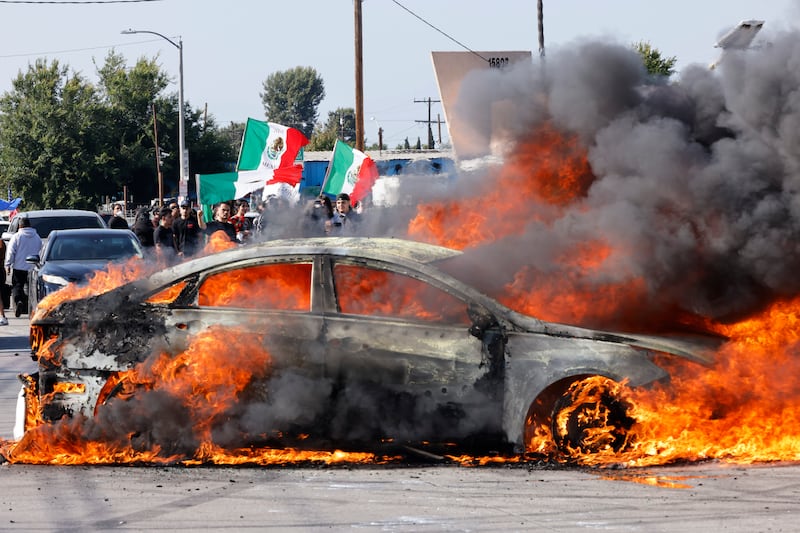Border czar Tom Homan struggled to explain a 2020 clip of President Donald Trump saying it wouldn’t be legal for the president to call in the National Guard without a request from a governor.
In response to demonstrations against federal immigration raids that began in Los Angeles on Friday, the president has taken the extraordinary steps of unilaterally deploying 4,000 federalized California State National Guard troops and sending hundreds of U.S. Marines to the city.
California Gov. Gavin Newsom has accused the president of intentionally “sowing chaos” in the city and sued to end the National Guard deployment, which he says was illegal.
During an interview with Homan, Trump’s hard-line border czar, CNN’s Kaitlan Collins pointed out there was a time when Trump apparently agreed with Newsom’s assessment.


She played a clip for Homan in which Trump, asked about Black Lives Matter protests in Oregon, says, “We have laws. We have to go by the laws. We can’t move in the National Guard. I can call ‘insurrection’ but there’s no reason to ever do that, even in a Portland case. We can’t call in the National Guard unless we’re requested by a governor.”
Then she asked Homan, “The law of course has not changed since then, so what has?”
“Look I’m not an attorney and all I know is I’m on calls every day with the heads of DOD and DOJ,” he said, using the acronyms for the Department of Defense and Department of Justice. “So, we’ve got legal minds in DOJ and DOD [who] are making these decisions, so I certainly think the president is acting within the confines of the law.”
Collins, however, pushed back, saying that Homan clearly knew the law well since he had also worked on deportations during Trump’s first term.

“I know immigration law very well, but I’m not an expert on constitutional law, or insurrection law,” he said. “That’s out of my lane.”
It is generally illegal for the U.S. military to conduct domestic law enforcement unless the president invokes the Insurrection Act, a compilation of statutes that allows the U.S. president to use the military to quash an armed rebellion or other insurrection, according to Lawfare.
As of Monday, Trump had not invoked the act, but he did issue a sweeping memorandum claiming to have the power to deploy National Guard troops at locations where protests against ICE functions are occurring or are likely to occur, The Hill reported.
Until last week, a president hadn’t federalized a state National Guard—which means the troops report to the U.S. Army—since 1965, when President Lyndon B. Johnson ordered Alabama State National Guard troops to protect civil rights advocates marching from Selma, Alabama, to Montgomery. Even then, the troops were called in to protect the protesters, not the police.

During a press conference on Sunday, Los Angeles Police Department Chief Jim McDonnell said the demonstrations in his city had turned violent over the weekend, with rioters setting off fireworks at officers and throwing pieces of concrete at police.
Video shows the police using tear gas, flash-bangs and non-lethal bullets to disperse crowds downtown.
According to McDonnell, though, the National Guard was called in prematurely. Normally, the police would have first made a mutual aid request to neighboring law enforcement agencies if they needed help ensuring public safety.

McDonnell also cautioned that the people committing violence at night were not the same people who had peacefully protested the ICE raids during the day.
The protests have followed a usual pattern of civil unrest where subsequent days are more violent because the legitimate protests attract rioters who “go from one civil unrest situation to another using the same or similar tactics,” he explained.
Many Angelenos were also quick to point out that the clashes were mostly restricted to fairly small geographic area in downtown Los Angeles, where several federal buildings are clustered but where very few of the city’s 4 million residents actually live.

Speaking to Homan, Collins said many people were likely wondering if this was really the worst protest that has happened since the 1960s, warranting federal intervention.
Homan first tried to accuse the state’s Democratic leadership of not taking action, but just minutes later he acknowledged that on Sunday night LAPD “did a pretty good job out there, you know, trying to quell some of this violence down.”
“Based on you saying the LAPD is doing their job last night, do you think that Marines would be necessary?” Collins asked.
“Last night was pretty out-of-control,” Homan replied. “And LAPD was out there in force. But we’ve got to remember... This is getting to be a significant public safety issue here. So President Trump’s thinking ahead of the game.”







